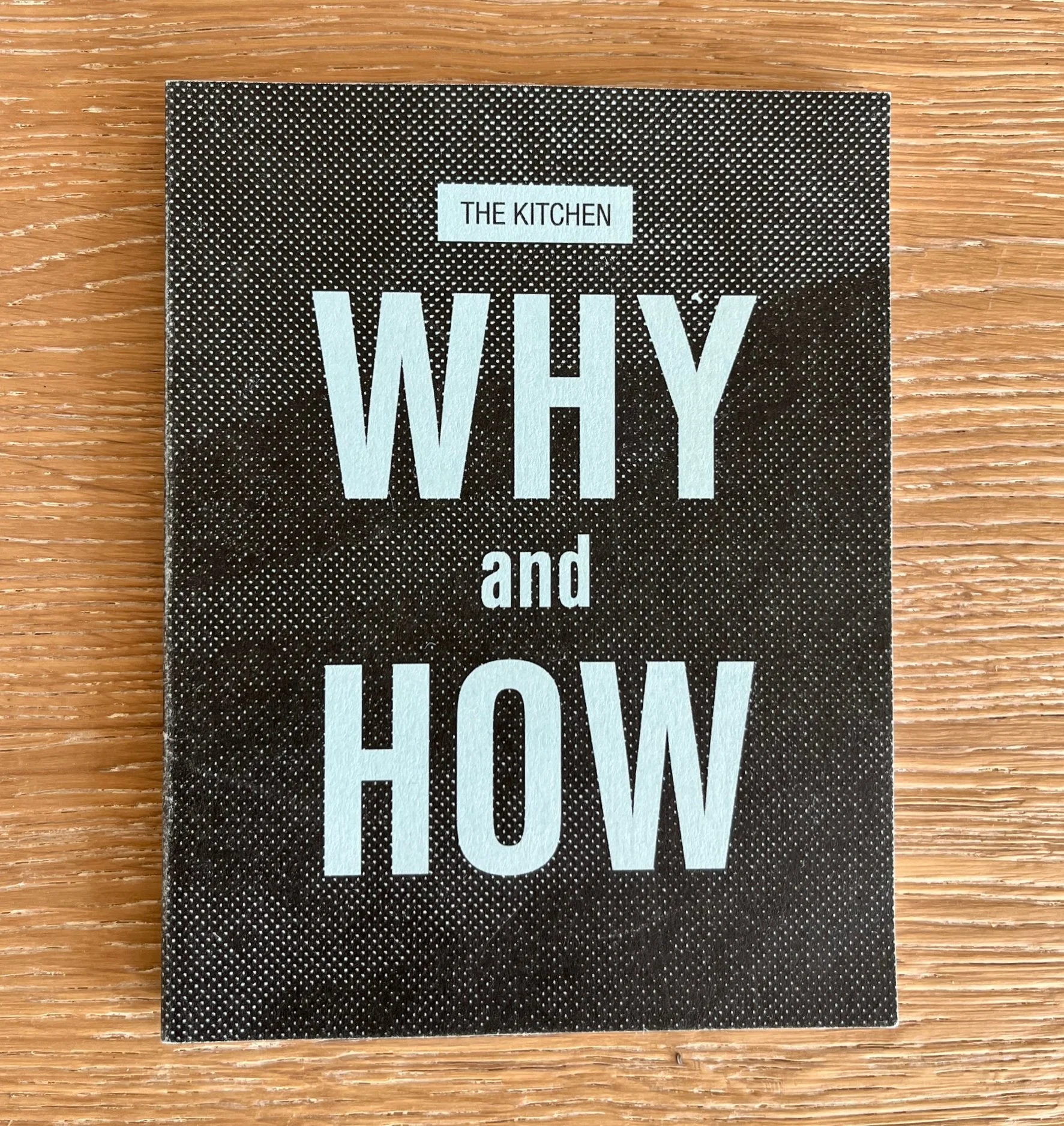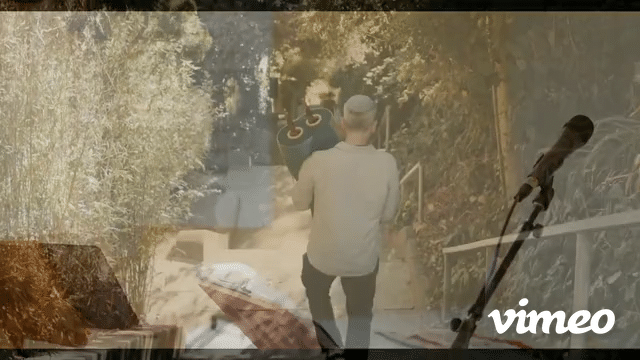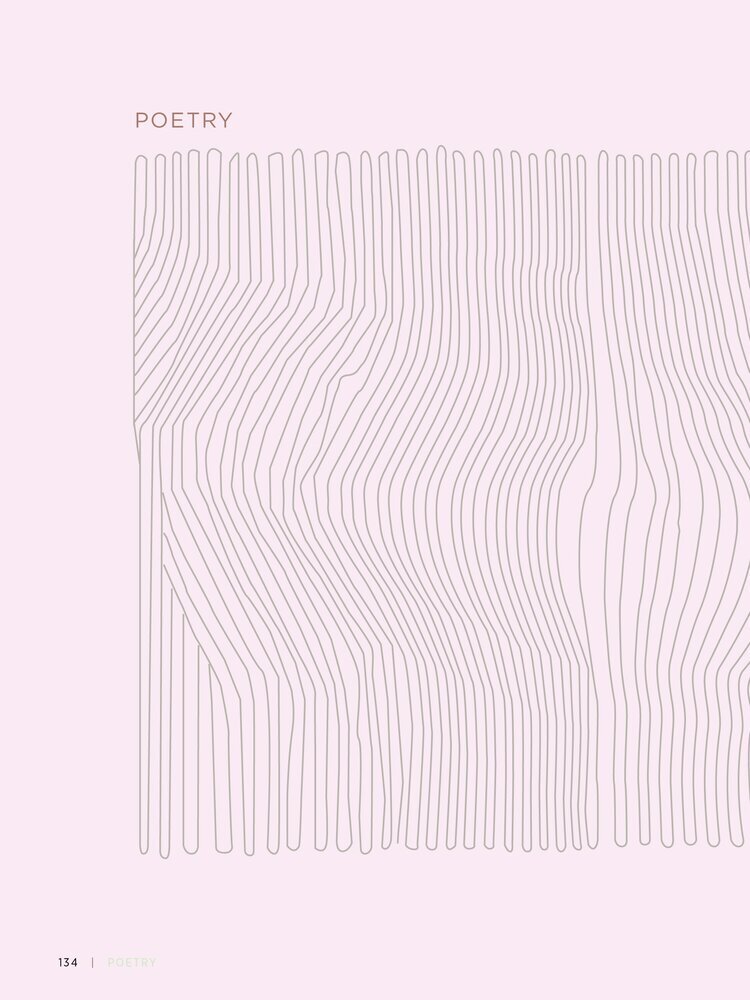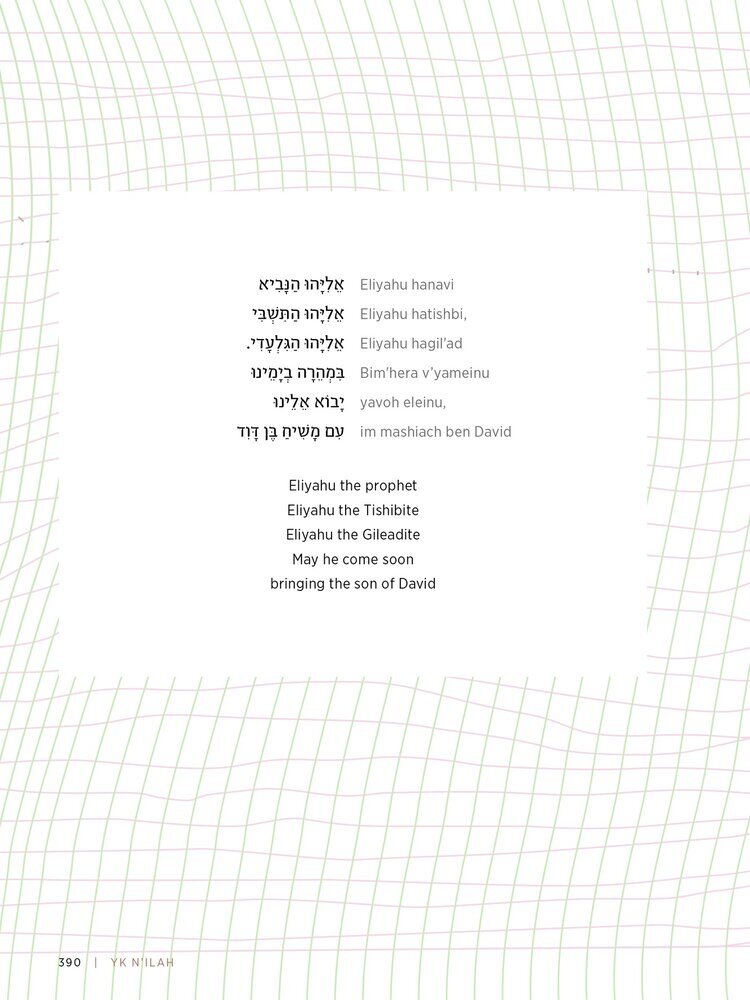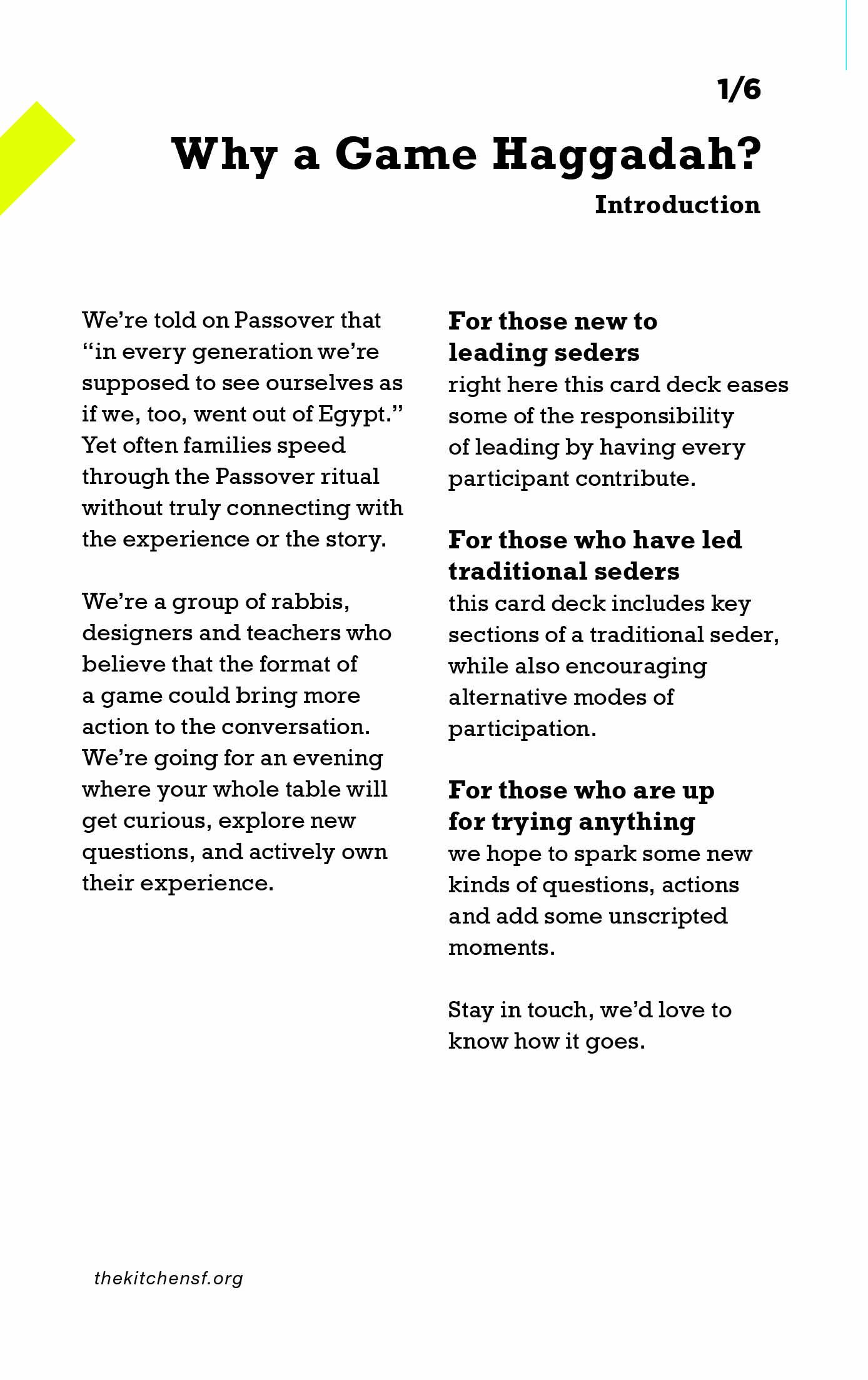Kitchen Portfolio: Design
Since 2011, we’ve brought our tradition to our people, what we call connecting heaven and earth. Here's what we did:Siddurim & Machzorim
2011 – Present
We create a siddur / prayerbook or machzor / high holiday prayerbook every few years. Why? So that we can evolve, adding prayers as we go. Knowing any given edition is not “forever” allows us to take more risks, too.
For every book, a group of Kitchen writers learn a few of the prayers in depth, offering their responses, which then become part of the books. Further, while our liturgy is comparable to many traditional places, we translate and transliterate every Hebrew word, so everyone who comes to The Kitchen can pray from the same book.
For the Machzor 2.0 edition, we were wondering whether images might help people access aspects of the high holidays. We created foldout pages, so that people could either interact with them or not. Some of the images were purposefully mundane – we put the page with the black and white photo of a telephone pole near the shema, the prayer of oneness. We wanted to suggest that holiness is everywhere.
-
Josh Levine & Alicia Greenleaf
-
Arranged & translated by Marilyn Heiss
Machzor V 1.0
-
Josh Levine
-
Arranged & translated by Marilyn Heiss
Siddur V 1.0
-
Josh Levine & Alicia Greenleaf
-
Arranged & translated by Marilyn Heiss
Machzor V 2.0
-
Designed by Chen Blume
-
Translation & Transliteration by Marilyn Heiss
Poetry by Harriet Heydemann, Anne Germanacos, Rachel Rosenberg, Katie Simpson and Evan Schnair
Siddur V 2.0
-
Designed by Josh Levine & Shelby Jones
-
Translation & Transliteration by Marilyn Heiss
Commentary by David Wilensky
Poetry by Meghan Adler, Zachary Bernstein, Anne Germanacos, and Evan Schnair
Machzor 3.0
Selections from Machzor V 2.0
Selections from Machzor V 3.0
Hello Mazel
2013 – 2015
Hello Mazel was born from the idea that we wanted people to create more jewish moments on their own, in their homes. So, under the guidance of then Executive Director Yoav Schlesinger, we designed a subscription box and every month, subscribers received a suite of things designed to surprise and prompt them to try something jewish.
My favorite were the two silver tokens, the size of monopoly player pieces, one in the shape of a sand dial, the other a globe. We gave people the famous teaching by Rabbi Simha Bunim: “Everyone must have two pockets, with a note in each pocket, so that they can reach into one or the other, depending on the need. When feeling lowly, read, ‘The world was made for me’ and when you are feeling high and mighty read, ‘I am but dust and ashes.’” We told the people these little tokens were reminders of this teaching, and suggested they keep them in their pockets.
The Passover Haggadah Game
2014
Brainchild of Gabe Smedresman, long-time Kitchen-ite, our Passover Game worked to solve the question of how to make passover seders more engaging for more people. Knowing the tradition asks us to interact, tell and live the exodus story, we took the haggadah and made it into a deck of cards, which could then passed out and “played.” Each card included ways to read or interact with the story or ritual described. This democratized the leadership of the passover experience, making many leaders instead of one.
Card 1 & 2
High(er) Holiday
Field Guide + Map
2016
One of the challenges we face (and we’re hardly alone) is that many people come to us for the first time during our most intense, complex and arduous days of the jewish year, the high holidays.
Some people learn by jumping right in but we know that when you are new and services are that long and intense, it is easy to get lost.
Wanting to make these days as powerful as possible for beginners, we created materials for before and during prayer so that anyone, no matter their background, could have a sense of the intent and framing of what we were all doing.
The high holiday map looks kind of like a game board and tracks the many events along the way. We intended it to read as if a trusted aunt or friend was giving the inside story, i.e., explaining when to bring kids and not, what the vibe would be at a given service, not to mention, when to bring a sweater.
The guide is more in depth, a little book of sorts, breaking down our services in larger conceptual sections, and offering interpretations for each. We print stacks and stacks of them every year and every year they’re gone. We hope this means the guide is allowing people to increase their comfort and familiarity with what’s going on.
2018
Why and How
We realized, thanks to Josh Levine, our strategist (title?), that our culture was a defining element of The Kitchen. In other words, what we did was not unlike religious practice in many other places. But why we do it and how is what consistently sets us apart.
Further, we realized that, as we grew, we could no longer sit with each and every person who interacted with The Kitchen and describe everything to them. So we tried to capture the feeling of those conversations
Torah Travel Video
2020
During the “shelter in place” phase of covid, as the high holidays approached, we desperately wanted to help people feel connected to torah and each other. We had the idea to take our torah scroll around to our people, in what we called our “San Francisco Hakafah.” Jacob Blumberg, our then video artist-in-residence, filmed Rabbi Michael Lezak (husband of Kitchen Rabbi, Noa Kushner) taking our Torah to the homes of Kitchen-ites over a period of two days. Then, during our Rosh Hashanah online service, in the moment when we’d normally be taking the torah around the room in services, we screened this video so that our people could still see members of the community holding and kissing our torah.
Kitchen-ite's visited by our torah
Mezuzah Project
2022
Board member Tommy Collison pointed out that when we go on or off line we cross a threshold of sorts, not unlike going in or out of a home. Given the internet, we figured having a mezuzah for just those moments could have religious meaning for a lot of people.
So, with the help of designer Chen Blume and Director of Marketing & Communications Sophie Stimola, we created a mezuzah stickers. They have a link listed that, when clicked, goes to the text of the shema (the prayer that is in all mezuzot). We recommend putting them on your keyboard or phone, wherever you might need to remember god and who you are before going online or returning back ‘home’ again.
Album
Shabbat in The Kitchen
2022
This album is the product of a creative collaboration between Rabbi Jessica Kate Meyer (Kitchen Rabbi/Hazan, 2018 - 2022) and our 2020 - 2022 artist in residence Jacob Blumberg, along with The Kitchen’s davening team and many stellar musicians. It recreates the feeling of entering shabbat for anyone, anywhere.
It is built on melodies from around the world, both ancient and contemporary, as well as drawing from the talent of local artists and Kitchen-ites, this music captures a powerful moment in the evolution of our shabbat services, conveying the melodies and t’fillot / prayers that allowed us to weather the pandemic and begin to heal at its end.
Learn more about the release of the album here.
Listen to the album below or launch your Spotify player here.
Rabbi Jessica Kate Meyer
Kitchen Rabbi / Hazzan
2018 - 2022
Jacob Blumberg
Kitchen Artist in Residence
2020 - 2022
Kitchen x Paris
2022
The Idea
Tamia & David B’Chiri experienced The Kitchen and were transformed. When they moved back to Paris, they missed our vibrant way of “doing jewish” and decided to try and bring this approach to Europe — so they called Rabbi Noa.
The New Jewish Movement in France
At the same time, a consortium of six synagogues, representing thousands of Parisian Jews, combined to form a coalition called Judaisme Enmouvement or JEM, including Copernique and Beaugrenelle (+ Liberal Jewish Movement of France). As progressive, non-orthodox communities, not recognized by the Consistoire, these jews wanted to further their modern jewish experience. Tamia and the leaders of JEM worked together to bring Rabbi Noa (& Rabbi Michael of GLIDE) to Paris with the aim of offering an example of modern Jewish life to JEM and the progressive jews of Paris.
The Kitchen in Paris
For an engagement of six days, Rabbi Noa taught Kitchen principles and demonstrated Kitchen experiences, leading sessions for educators, rabbis, 20’s + 30’s, entrepreneurs, communications professionals, people already involved as well as those simply curious.
A “user focused” experience model of Jewish life, where shabbat services are designed centralizing the perspective of participants
Our approach to “doing Jewish” which prioritizes willing and engaged participation
The specific connection of Jewish practice and belief with acts of universal justice (relatively unknown in France).
Early Results
Our resources and ideas are now incorporated into the existing synagogues, and Tamia and David now regularly host shabbat for 150 Parisians previously estranged from religious life. One year later, not only is enthusiasm developing, with new stakeholders coming forward, the necessary structures of community are developing and the relationships and collaborations continue.
Siddur V 3.0
& Recordings
Coming Winter 2023
With the arrival of Kitchen Hazzan Asher Shasho Levy, we’ve been lighting up our shabbat with piyyutim (prayer poems), energy and melodies from places like Morroco, Turkey, Syria, Yemen, and Uzbekistan, to name just a few.
We’re creating a new version of our prayerbook to go with it too, complete with these new / old piyyutim, and accompanied by translations written by Hazzan Shasho Levy – making many of them accessible in english for the first time.
Our siddur may well be one of the first Sephardi / Ashkenazi integrated prayer books in the US but that’s not why we’re doing it. We just want the most inspiring material in our hands, available for Kitchen-ites and would be Kitchen-ites around the world.
We’ll be recording these piyyutim and t’fillot / prayers in the studio this fall, so everyone can sing along during the week and get ready for when shabbat finally arrives.
Launch for book and tracks: Hannukah 5783.
Listen to our shabbat songs below.




